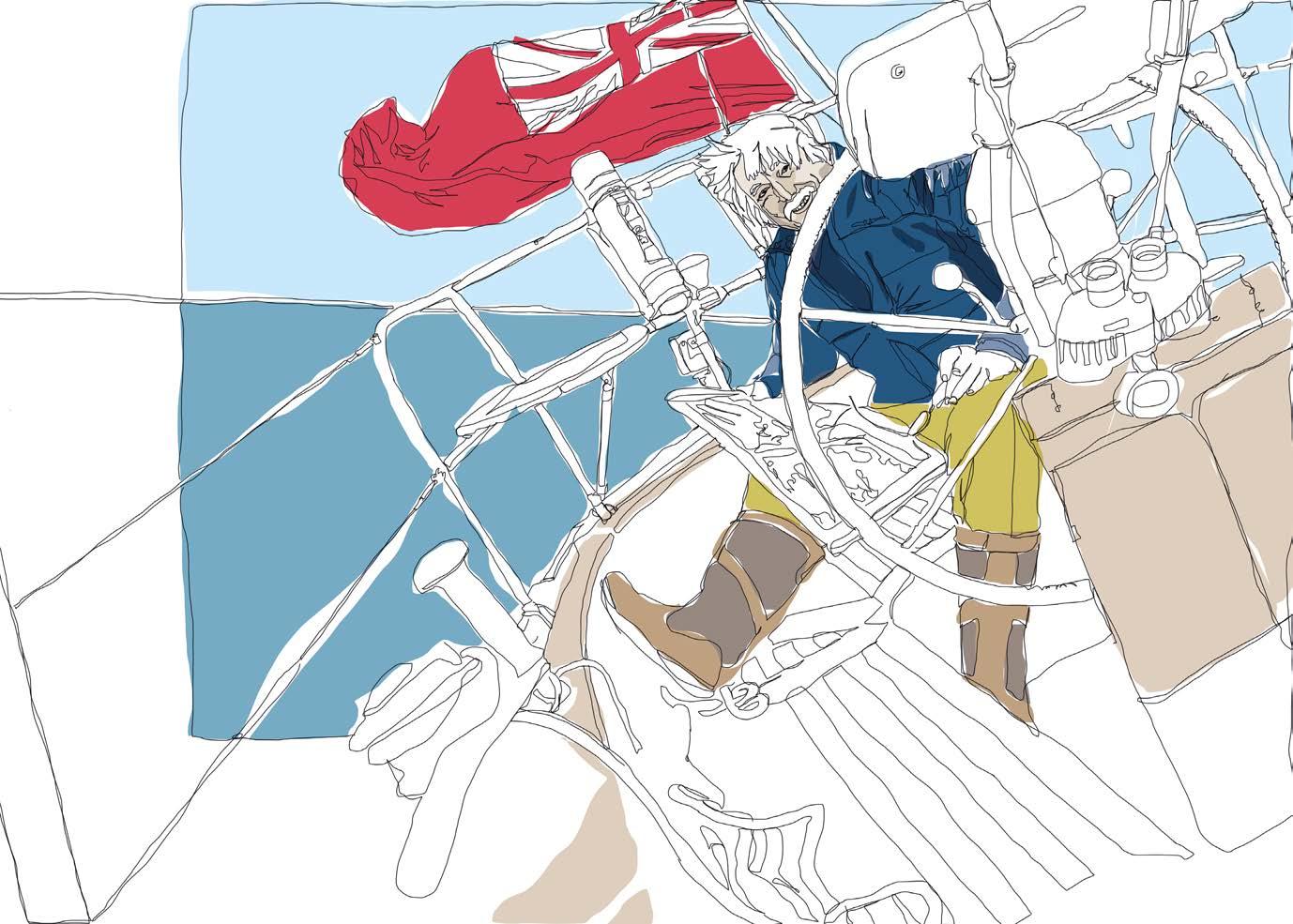
8 minute read
How to Win
Tide lines
Mark Rushall explains how to read tidelines and use them to advantage
If you watched the live coverage of the Finn Olympic medal race in Japan this summer, you may have heard Giles Scott vocally encouraging the wind to shift left as he progressed up the first beat.
“Tidal shift, lifting lefties, come on!”
This was not a surprise: after returning to re-start when the X flag was displayed, Giles took an uncharacteristically large split to the left of the fleet. And it appeared to pay off: the leader came from the left, and Giles rounded the mark having put himself back in the race.
The snap (below) from the harbour wall of the race area before the start gives a clue as to why the tuned-in sailors might have been able to predict a left shift. There is a distinct difference in colour between the water at the top of the beat, compared to that in the vicinity of the jury boats. Is it a tide line?
What is a tide line?
A tide line often forms at the interface of two bodies of water that are (or have been) moving in different directions or at significantly different speeds. Some of the most dramatic examples I’ve experienced are at the confluence of the Rio Negro (the clue is in the name) and the Amazon, near Manaus, Brazil where the line between the fast and slow streams are marked by completely different temperatures, and shades of brown and black. And at Rio de Janeiro, venue of the 2016 Olympics, where the cold, salty flood tide ducks under - rather than mixing with - the warm, brackish ebb. In Rio, with these two streams moving at up to a knot in opposite directions, the line in the water looks like the drain cycle of a city’s worth of washing machines, with plenty of organic and inorganic flotsam mixed in.
More often though, the difference is more subtle: a slightly different colour shade, a line of bubbles and weed, or a slight difference in wave pattern each side of the line.
ABOVE
The start of the 2020 Olympic Finn medal race, where GBR's Giles Scott went on to seal gold with his tidal tactics
BELOW
View from the harbour wall over Enoshima Bay; note the change in water colour

Why is it important?
If there is a tide line on the course, it is highly probable that the flow is non-uniform. That means, other variables being equal, there is a racing gain to be made. To work out where that might be, it may be helpful to think of the tidal effects in terms of three questions:
Where is the tide taking me, or 'set'?
On an upwind leg, unless the tide or current is at right angles to the wind I’m sailing in, there will either be a component of flow helping me towards (favourable), or pushing me away from (adverse), the upwind direction. If the flow is not uniform


across the race-course, it generally makes sense to choose a route that gives me the maximum time in favourable tide.
How does that a ect my sailing wind?
If the tidal ow is di erent either side of a tide line, it follows that the sailing wind (see box, right) must be di erent, in speed, direction, or both. at gives us an opportunity to make a choice that gives a faster or shorter route, just as we would with wind shi s, wind bends, or areas of increased wind speed in a non-tidal venue. If I’m expecting a gain due to more wind against tide, I do need to know that this won’t be o set by my boat’s characteristics in the rougher water that may result.
How are the laylines a ected?
I need to answer both questions above to make sure I don’t waste time sailing extra distance by overstanding the mark, both upwind and downwind.
How can I tell what is happening on each side of the tide line?
e only way to be sure is to physically measure the tide in each location. A coach would do that with a tide stick. For most of us that’s not
ABOVE RIGHT
Coach boat view from Rio 2016 - wind against tide shows to the right of the tide line, wind with tide to the le
INSET
Subtle di erences on the water's surface can help you determine the tide
COACH SAYS: UNDERSTAND ‘SAILING WIND’
Coaches often measure tide fl ow very simply by dropping a tide stick, which sits vertically in the water with just enough exposed above the water to be able to locate it. We drop the tide stick next to a fi xed point (or a GPS waypoint) and measure how fast and in what direction the stick travels.
Try a thought experiment. Imagine that there is a burgee fi xed to the top of a fl oating tide stick, with 2 knots of uniform north-bound tidal fl ow, in a complete fl at calm, in the middle of the Atlantic. The burgee will display wind in the opposite direction to the fl ow (from the north), and fl ap just as it would in 2 knots of ‘real’ wind. We could happily sail around perfectly normally in this two knots of ‘tidal wind’, and with no land, fi xed marks, or GPS to tell us otherwise, so long as we didn’t have somewhere we needed to get to, we’d be completely oblivious of the tide. An anchored committee boat would continue to measure no wind (the ground wind), while we would feel and measure the tidal wind.
Next, imagine that the tide stays the same, but the ‘real’ (ground) wind fi lls in at 2 knots from the west. The wind we feel and sail in will now be the combined e ect of the ground wind, and the tidal wind. The wind the burgee on the tide stick now measures is the vector sum of the tidal wind and the ground wind: the sailing wind. In this case the sailing wind will be just under 3 knots from the north-west.
Tide 2k Tidal wind 2k Tidal wind 2k Sailing wind 2.8k Sailing wind 2.8k
Ground wind 2k Ground wind 2k
an option, but there are some possibilities…
Inside knowledge
Tidal flow charts are available for many sailing venues, and a tide line may simply be a confirmation of an effect we are already expecting. In that case, it is great to have the line drawn for us on the water.
Repeating themes
Around high or low tide we often expect the flow to reverse close to the shore first. The tide line gives a good indication of this effect, and just where the discontinuity is.
Wave patterns
Flatter water one side of a tide line suggests that the tide may be flowing with the wind in that location, rougher water the other side suggests wind against tide.
How does it feel?
If you sail through a tide line and feel a change in pressure or a shift, repeat to test whether it is a tidal effect. (Don’t forget to check your foils for weed afterwards, though!)
Transits
It may be possible to measure a tidal change across a tide line by checking against a transit before and after crossing the line. Or noting other boats’ changing movements against the land behind, either side of the line.
How about downwind?
Though the principles are the same downwind, there is another consideration. On a beat, more favourable tide also means a corresponding increase in sailing wind speed. That’s a win-win situation. But on the run, an increase in favourable tide means a decrease in sailing wind speed. The gain is therefore not so big as it was upwind. An extreme apparent wind craft may benefit more from a 2 knot increase in sailing wind speed than they lose from the 2 knot adverse tidal set that causes it. We saw that in the San Francisco America’s Cup, where the strategists were seeking out the strongest adverse tide on the run.

What if there is no tide line?
No tide line does not necessarily mean that the tide is uniform: there could be a tidal gradient where the speed and/or direction progressively change with position, rather than a line marking the discontinuity. The same principles as discussed here apply to a race course with a tidal gradient.
If the flow direction is uniform across the racecourse, being clear how the laylines are affected will minimise overstands and keep strategic options open. If there is a cross tide element, you can predict the shift in the sailing wind that a decrease or increase in the wind speed will cause. Remember, if the tidal flow increases, or the wind drops, the sailing wind will shift further away from the ground wind.
ABOVE
The tide is flooding in the background, ebbing in the foreground - you can just see the tide line between
BELOW
Giles Scott headed left to take advantage of a tide line further up the course
BELOW RIGHT
Surveying the water before the start gave Giles the ultimate medal race advantage
What about the leebow effect?
‘Leebow’ means different things to different sailors: as a coach I find the term unhelpful. There is no magical step change in performance caused by the adverse tide being a few degrees either side of the optimum close-hauled angle. What is important is the tidal flow relative to the wind direction, and the subsequent effect on your sailing wind and your course.
Back to the medal race...
The change in colour was indeed a visual cue for a split in the tide. There was a negligible tidal flow in the starting area, but around 1 knot from right to left looking upwind in the darker water further up the course. In 8 knots of wind, that gives a 7 degree left shift in the sailing wind. Even allowing for the usual wind shifts and pressure patches over the course, that knowledge makes the left split a pretty good bet. The rest is now history!












